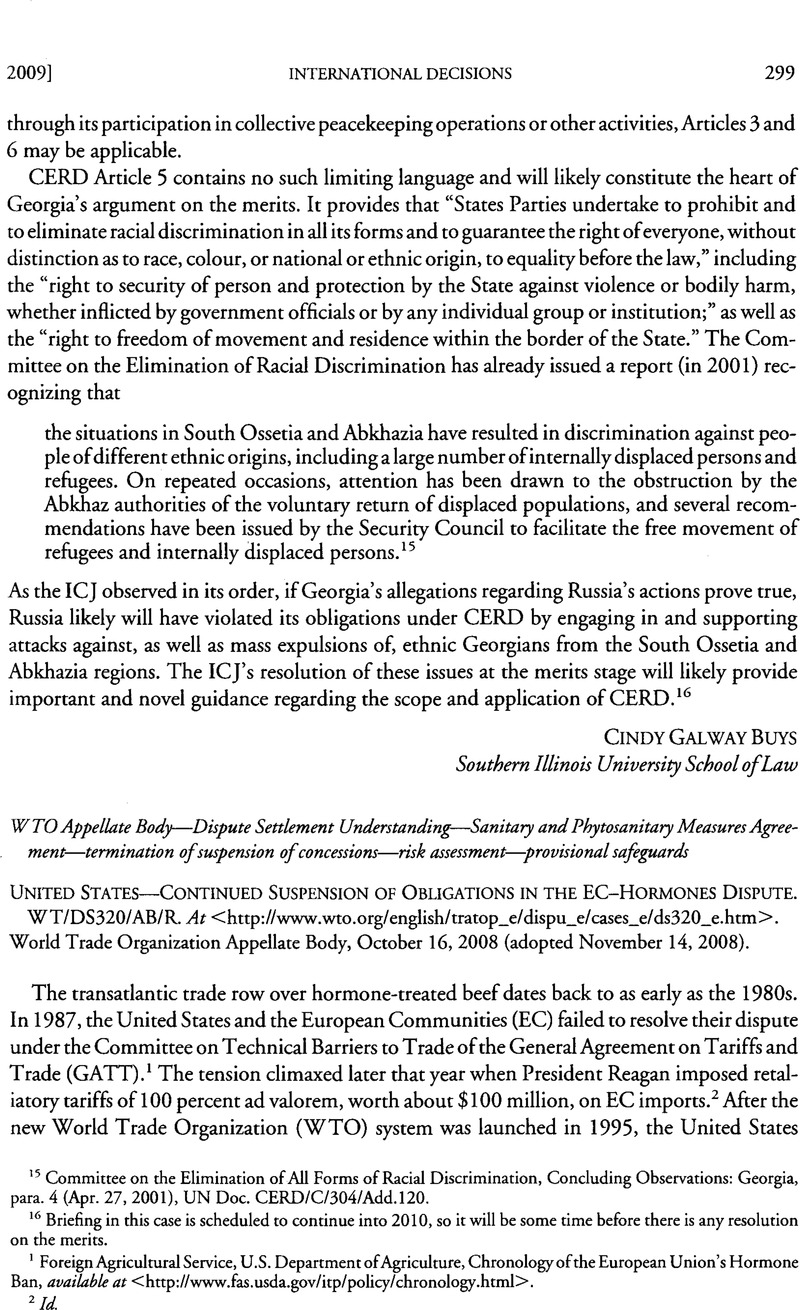Published online by Cambridge University Press: 27 February 2017

1 Foreign Agricultural Service, U.S. Department of Agriculture, Chronology of the European Union’s Hormone Ban, available at <http://www.fas.usda.gov/itp/policy/chronology.html>.
2 Id.
3 Apr. 15, 1994, Marrakesh Agreement Establishing the World Trade Organization, Annex 1A, in World Trade Organization, The Results of the Uruguay Round of Multilateral Trade Negotiations: The Legal Texts 20 (1994)Google Scholar, reprinted in 33 ILM 1154 (1994). The legal texts are available online at <http://www.wto.org/english/docs_e/legal_e/legal_e.htm>. See also Request for Consultations by the United States, European Communities—Measures Affecting Meat and Meat Products (Hormones), WT/DS26/1 (Jan. 31, 1996). Materials on specific WTO disputes are available online at <http://www.wto.org/english/tratop_e/dispu_e/find_dispu_cases_e.htm>.
4 See Panel Report, European Communities—Measures Concerning Meat and Meat Products (Hormones), WT/DS26/R/USA, paras. 2.1–2.5, 8.1, 8.2 (adopted Feb. 13, 1998), modified by Appellate Body Report, European Communities—Measures Concerning Meat and Meat Products (Hormones), WT/DS26/AB/R (adopted Feb. 13, 1998) [hereinafter EC—Hormones]. A case report by David A., Wirth on the Appellate Body decision appears at 92 AJIL 755 (1998)Google Scholar.
5 See Panel Report, EC—Hormones, supra note 4, paras. 2.8, 2.9.
6 Article 5.1 provides: “Members shall ensure that their sanitary or phytosanitary measures are based on an assessment, as appropriate to the circumstances, of the risks to human, animal or plant life or health, taking into account risk assessment techniques developed by the relevant international organizations.”
7 Appellate Body Report, EC—Hormones, supra note 4, para. 208 (emphasis added).
8 See Decision by the Arbitrators, Recourse to Arbitration by the European Communities under Article 22.6 of the DSU, EC—Hormones, WT/DS26/ARB, paras. 83, 84 (July 12, 1999).
9 See Appellate Body Report, United States—Continued Suspension of Obligations in the EC—Hormones Dispute, WT/DS320/AB/R, para. 488 (adopted Nov. 14, 2008), modifying Panel Report, United States—Continued Suspension of Obligations in the EC—Hormones Dispute, WT/DS320/R, (adopted Nov. 14, 2008) [hereinafter U.S.—Continued Suspension].
10 Appellate Body Report, U.S.—Continued Suspension, supra note 9, paras. 489–90, 622.
11 Id., para. 493.
12 Request for Consultations by the European Communities, U.S.—Continued Suspension, WT/DS320/1 (Nov. 10, 2004).
13 Panel Report, U.S.—Continued Suspension, supra note 9.
14 Id., para. 7.251.
15 Id., para. 7.537.
16 Article 5.7 provides: “In cases where relevant scientific evidence is insufficient, a Member may provisionally adopt sanitary or phytosanitary measures on the basis of available pertinent information, including that from the relevant international organizations as well as from sanitary or phytosanitary measures applied by other Members. In such circumstances, Members shall seek to obtain the additional information necessary for a more objective assessment of risk and review the sanitary or phytosanitary measure accordingly within a reasonable period of time.”
17 Panel Report, U.S.—Continued Suspension, supra note 9, para. 7.648.
18 For an excellent analysis on the DSU issues (Articles 21–23) arising under this dispute, see Markus, Böckenförde, Hormone Ban in Dispute Again: The WTO Refuses to Reject Either the EC Ban or Canadian/US Trade Sanctions, ASIL Insights (Dec. 18, 2008), at <http://www.asil.org/insights081218.cfm>Google Scholar.
19 The Appellate Body report explained: “This is problematic in this case because the European Communities’ risk assessment called into question the validity of the [Joint FAO/WHO Expert Committee on Food Additives]’s evaluations and explicitly stated that it would not follow them. In the light of this, it was improper for the Panel to consult with Drs. Boisseau and Boobis, who were directly involved in JECFA’s evaluations” (para. 477).
20 Communication from the United States on Concerns Regarding the Appellate Body’s Report, U.S.—Continued Suspension, WT/D5320/16, para. 26 (Nov. 12, 2008).
21 Id.
22 Paragraph 5 of Annex A defines the appropriate level of sanitary or phytosanitary protection as the “level of protection deemed appropriate by the Member establishing a sanitary or phytosanitary measure to protect human, animal, or plant life or health within its territory.”
23 Panel Report, U.S.—Continued Suspension, supra note 9, para. 7.644.
24 The full quotation from the Appellate Body report in U.S.—Continued Suspension is as follows: “[T]he fact that the WTO Member has chosen to set a higher level of protection may require it to perform certain research as part of its risk assessment that is different from the parameters considered and the research carried out in the risk assessment underlying the international standard” (emphasis added).
25 Appellate Body Report, Japan—Measures Affecting the Importation of Apples, WS/DS245/AB/R, para. 179 (Nov. 26, 2003) [hereinafter Appellate Body Report, Japan—Apples].
26 Appellate Body Report, EC—Hormones, supra note 4, para. 194.
27 See also Appellate Body Report, Japan—Apples, supra note 25, para. 185.
28 See generally Sungjoon, Cho, Of the World Trade Court’s Burden (Mar. 2007), at <http://ssrn.com/abstract=969437>Google Scholar (arguing that the WTO tribunal should not engage in any “substantive” adjudication on issues involving risk science and should instead focus on “procedural” obligations of parties concetned).
29 More specifically, the Appellate Body report in U.S.—Continued Suspension provides: “However, some of the scientific experts consulted by the Panel indicated that risks arising from residues of oestradiol-17)8 in bovine meat are likely to increase where good veterinary practices in the administration of this hormone are not followed” (para. 547); “In response to another question on the subject posed by the Panel, Dr. De Brabander recognized that ‘[i]mproper administration of implants or misplaced implants create potential hazards to human health’” (para. 550); and “At least two of the scientific experts consulted by the Panel recognized that the misuse or abuse in the administration of the hormones could give rise to adverse effects” (para. 553).